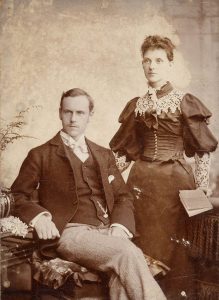Historical Fact and Historical Fiction

An English couple photographed in 1895, Public domain (https://commons.wikimedia.org/wiki/File:Photograph.sept1895.jpg)
Today, I’ll be returning home from an annual gaming convention. By some luck of the draw and my interests, I wound up playing in three quasi-historical games this year. Two of the three were alternate history games, one with a fairly close correlation to the Wild West, but with a heavy splash of horror, and the other set in a world where World War II did not go as it really did. The third game, set in Gold Rush California, was roughly 90% historically accurate, with one tweak to the actual history because it was a cool addition.
When it comes to writing alternate history, it’s almost inevitable that you’re going to make some tweaks to reality–that’s kind of the point. In the case of this game, the tweak was to change when a specific group was active in the setting, making them contemporaneous with the rest of the plot rather than a couple of years earlier. But because the person running the game had done substantial research, he was able to integrate this change really smoothly–in fact, had he not told us about it, I don’t think we would have realized that it was slightly inaccurate to reality.
And that’s the most important thing to do when you’re writing alternate history. Know the story, know what you’re changing, and figure out how to integrate that change as seamlessly as possible. If you go for a major change (for example, changing the end result of a war), there are a lot more details to work out. Minor changes (like a gang that had really existed a couple of years earlier) can slip in much more easily. If you want to go for the broader scope of change, it likely lends itself to a larger project, whereas a small change might work best for a shorter project (but could also be the impetus for something bigger).

Comments